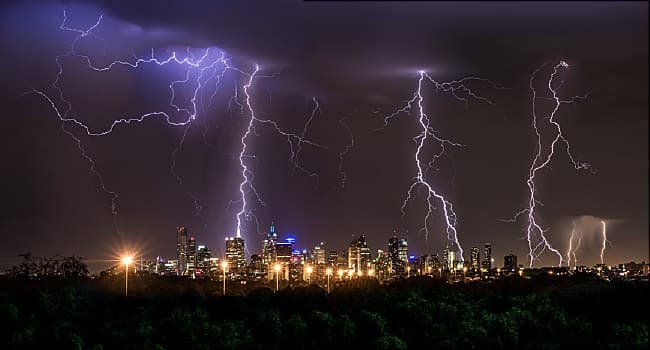[ad_1]
Sept. 22, 2022 — Sonia Chavez was on the balcony of her midrise Dallas apartment when the unthinkable happened: As she was filming a thunderstorm with her cellphone, lightning struck her in a flash of blinding light and searing heat that knocked her off her feet.
The thunderbolt, which Chavez captured on film, damaged her eyes and left her with some cognitive, speech, and mobility issues.
But somehow, she survived.
“When it hit, it sounded like a bomb going off,” says Chavez, 38. “I felt this intense electric force that hit me hard, like a gut punch or whiplash. It was the biggest pain you could imagine. I remember seeing the electricity coming off my hands and seeing different colors — blue, then red, and then white — and there was ringing in my ears.
“I don’t remember much after that, but the next thing I knew I was in the closet of my apartment, pinching and scratching myself to see if I was dead or alive.”
As traumatic as the experience was, Chavez is one of the lucky ones. While she is still recovering from injuries caused by the strike 18 months ago, she lived to tell her story.
Many others struck by lightning don’t. And lightning fatalities are on the rise in the U.S., possibly due to an increase in severe storms tied to global climate change.
So far, the U.S. has recorded 17 lightning fatalities this year, according to the National Weather Service (NWS). That’s more than the 11 that occurred by this time last year and as many as were seen in all of 2020.
“I do feel like I’ve been lucky,” says Chavez, who is receiving physical and speech therapy, as well as ongoing treatments to address her vision loss from the strike. “I’ve had teams of people helping me, including my husband, who found me in the closet a half-hour after it happened [and] got me to the hospital.”
Aaron Treadway, a lightning specialist with the National Weather Service, explains that lightning-strike survivors like Chavez are not as rare as you might think. Indeed: Nine in 10 people struck by lightning survive the incident.
“On average around 300 people are struck by lightning each year, with roughly 10 percent of those being fatal injuries,” says Treadway. “For those who are struck and do not die, many have serious injuries.”
While lightning fatalities have been rising in recent years, they are still well below what they were 20 years ago, he says. Between 1970 and 2000, the average annual lightning death tally was over 70, National Weather Service figures show.
“The reduction in fatalities [since 2000] is due to the success of the lightning safety campaign that many people and organizations have contributed to,” Treadway says. “These include NWS offices across the country and our many partners in the broadcast and print media, outdoor and sports organizations, emergency management officials, and other safety organizations.
“Sayings like ‘When Thunder Roars, Go Indoors’ or ‘See a Flash, Dash Inside’ for our deaf and hard-of-hearing community are easy to remember and apply, keeping people safe.”
Lightning Strikes: By the Numbers
The National Weather Service maintains a detailed website of facts on lightning strikes that provides a compelling overview of how, when, and where people die during thunderstorms.
It offers a glimpse into the kinds of activities individuals were engaged in at the time of fatal strikes, providing key clues to how best to avoid risky behaviors during a storm.
For instance, of the 17 lightning deaths so far this year:
- Five people were struck during camping trips or visits to public parks.
- Four were killed while engaging in water sports: boating, jet skiing, or swimming.
- Four were hit as they were working around the house: doing yard work, loading tools into a van, standing on a roof, and replacing a window.
- Four died while walking a dog, flying a remote-control plane in a field, fixing a truck on a highway, and during Army training exercises.
The National Weather Service has also compiled an extraordinary online database of lightning survivors, including detailed interviews, their stories, and the health impacts they suffered.
Beyond these personal stories, the National Weather Service has publicized a wealth of information on these giant sparks of electricity in the atmosphere that often strike the ground.
According to the National Weather Service and other federal agencies:
- A typical lightning flash carries about 300 million volts. By comparison, a household current is 120 volts.
- Lightning can heat the air it passes through to 50,000 degrees Fahrenheit. That’s five times hotter than the surface of the sun.
- Lightning strikes somewhere in the U.S. 25 million times each year on average.
- Florida is the nation’s lightning capital, with the highest average number of cloud-to-ground strikes, ranked by flashes per square mile. The Sunshine State also has the most fatalities of any state due to the frequency of lightning and because most people are outdoors during the peak lightning season (June to August).
- Florida sees 1.2 million strikes in a typical year, covering 20 square miles. Next in line: Louisiana (875,136, 18.9 miles); Mississippi (768,126, 16.1 miles); Oklahoma (1.1 million-plus, 15.8 miles); and Arkansas (837,978, 15.7 miles).
- Worldwide, the U.S. had the second most lightning strikes in 2021. Brazil was first.
- Certain occupations carry a higher risk for lightning strikes, including those in the logging, construction, utility, lawn services, and recreational industries, according to the U.S. Occupational Safety and Health Administration.
National Weather Service officials have also collected a surprising list of lightning myths and facts. They are:
- Crouching down or lying flat on the ground in a thunderstorm won’t reduce your risk of being struck. You can still be vulnerable to ground current from bolts that strike the earth nearby. It’s better to run to a building or vehicle for shelter.
- Lightning can strike twice in the same place and often does. The Empire State Building is hit 23 times every year, on average.
- Even if it’s not raining outside you can still be struck by a “bolt from the blue” — literally — because lightning can strike 10 to 15 miles from the center of a storm.
- Metal watches, jewelry, and personal electronic devices such as cellphones and portable music players do NOT attract lightning.
- Your mother was right: Don’t stand under a tree during a storm. Being beneath a tree during a storm is the second-leading cause of lightning fatalities.
Why Are Fatalities Up and What Can You Do?
What’s behind the recent increase in fatal lightning strikes? Treadway says global climate change might be a factor. But he notes scientists aren’t entirely certain, in part because they have not been tracking the weather phenomenon for very long.
“While a warming climate will produce more ingredients that are conducive to the development of thunderstorms, quantitatively, the period of record of ground-based lightning detection is fairly short,” he explains. “In order to say that there is a substantial increase in lightning coverage, scientists need to have a longer period of data to make those types of conclusions.”
But that research has shown that education and awareness or risks can help reduce lightning fatalities overall.
“Lightning doesn’t follow rules; it strikes where it wants to,” he says. “It is up to the public to take those safety precautions and reduce their risk of getting struck overall.”
With that in mind, National Weather Service officials recommend keeping the following safety tips and information in mind to reduce your risk during an electrical storm:
- If you can hear thunder, lightning is close enough to strike you, so you should seek shelter in a building or hard-topped vehicle with the windows rolled up.
- Wait 30 minutes after you hear the last crack of thunder before going outside.
- Stay off landline phones, computers, and other electrical equipment that put you in direct contact with electricity during a storm.
- Avoid plumbing, including sinks, baths, and faucets.
- Stay away from windows and doors, and don’t venture onto porches or balconies.
- Don’t lie on or lean against concrete walls.
- Avoid elevated areas such as hills, mountain ridges, and peaks if you’re caught outdoors and can’t seek shelter.
- Don’t lie flat on the ground, and keep away from trees or objects that can conduct electricity (like metal or wire fences, power lines, and windmills).
- Don’t swim or go near ponds, lakes, or other bodies of water.
Treadway also recommends checking weather forecasts before engaging in outdoor summer activities and adjusting your plans accordingly.
“About two thirds of the victims were enjoying outdoor leisure activities before being struck, with water-related activities topping the list,” he notes. “Of the water-related activities, fishing ranked highest, with boating and beach activities also contributing significantly to the water-related deaths.
“Camping, ranching/farming, and riding an exposed vehicle (bike/motorcycle) also ranked highly in activities people were doing when fatally struck. Among the sports activities, soccer ranked highest, followed by golf and running. … Interestingly, about 80% of lightning fatalities are men.”
Looking back on her experiences, Chavez says she knew she was taking a risk standing on her balcony, filming the electrical storm on the day she was struck by lightning. She acknowledges that she didn’t believe she was at risk because it was not raining outside, which she now knows is a dangerous falsehood.
She is still in recovery.
“I’m a work in progress,” she says, noting that she struggles with vision problems and mobility. She speaks slowly and deliberately, but articulately, about her experiences.
But Chavez says she is regaining her abilities little by little every day. She recently returned to work as a project manager and even started jogging again — something she had to give up after the strike.
There is one surprising development she attributes to the lightning strike, she says: The experience gave her a new outlook on life and that her mind is calmer, with less “brain chatter” than before.
“Through this journey, I actually feel very blessed,” she says. “Having had a near-death experience completely changes your outlook on life. And even though this created such havoc on my mind and body, it actually helped my soul.
“The brain chatter I used to experience is gone because I can only concentrate on the current moment. And to me that is just so peaceful. You just hit this different space, and a few other survivors will tell you that they have felt similar things.”
Chavez also says she feels compelled to share her story, believing it may help others avoid what happened to her as well as those who’ve survived lightning strikes.
“There needs to definitely be more education around what happens to people who have been impacted by a lightning incident [and] who have experienced electrical shock in general,” she says. “A lot of us experience the same things, they do rattle our brains and nervous systems, and it’s not as rare as you think.
“I want to help as much as possible to spread awareness in hopes that it helps someone else.”
[ad_2]
Source link






